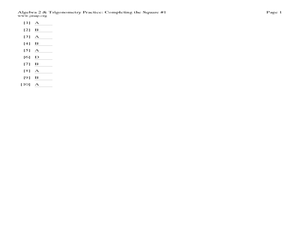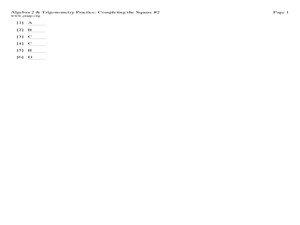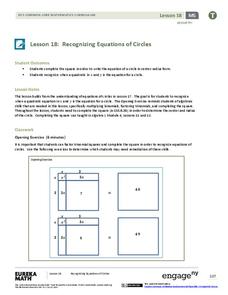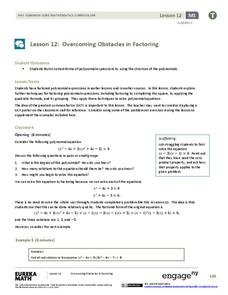Curated OER
Completing the Square
Solve equations by completing the square. The pupils factor quadratic equations and graph the parabola. They also identify the different terms in the equation and look for patterns.
EngageNY
Completing the Square (part 1)
Avoid the trap of memorizing steps when completing the square with a resources that provides a conceptual approach to completing the square. Learners that are able to recognize a perfect square trinomial are ready to complete the...
EngageNY
Completing the Square (part 2)
Give classes confidence in completing the square with a resource that develops the process of completing the square of more complex problems, including fractions and values greater than one. It then uses quadratic modeling for...
EngageNY
Solving Quadratic Equations by Completing the Square
Many learners find completing the square the preferred approach to solving quadratic equations. Class members combine their skills of using square roots to solve quadratics and completing the square. The resource incorporates a...
Curated OER
Completing the Square
In this completing the square worksheet, students solve given equations by completing the square. They simplify equations before solving them. This three-page worksheet contains five problems.
Curated OER
Application of Completing the Square
A TI technology activity that helps learners to recognize and use the characteristic of a perfect square quadratic to complete the square. Additionally, they apply their knowledge to solve real-world problems.
Curated OER
Completing the Square #1
For this Algebra II worksheet, 11th graders solve quadratic equations by completing the square. The one page worksheet contains ten problems. Answers are provided.
Curated OER
Completing the Square #2
In this Algebra II worksheet, 11th graders complete the square to solve quadratic equations. The one page worksheet contains six problems. Answers are provided.
Explore Learning
Quadratics: Polynomial Form
Throught this subscription-based sight, learners explore different aspects of the parabola by changing equations from standard to vertex form. Next, find the general form of the vextex based on the values of a, b, and c, and investigate...
EngageNY
Recognizing Equations of Circles
What does completing the square have to do with circles? Math pupils use completing the square and other algebraic techniques to rewrite equations of circles in center-radius form. They then analyze equations of the form x^2 + y^2 + Ax +...
Curated OER
Completing the Square #3
In this Algebra II worksheet students solve quadratic equations by completing the square. The one page worksheet contains ten problems. Solutions are not provided.
Curated OER
Solve One Quadratic Equation by Completing the Square
In this completing the square worksheet, students solve one quadratic equation by completing the square. The solution is provided.
Curated OER
Completing the Square
In this Algebra II worksheet, 11th graders respond to a journal prompt in which they write their own quadratic equation and solve it by completing the square. The one page worksheet contains three questions. Possible answers are...
EngageNY
Deriving the Quadratic Formula
Where did that formula come from? Lead pupils on a journey through completing the square to discover the creation of the quadratic formula. Individuals use the quadratic formula to solve quadratic equations and compare the method to...
West Contra Costa Unified School District
Solving Quadratic Equations – Alternative Methods
There's more than one way to solve quadratic equations. Scholars learn how to solve quadratic equations using alternate methods. They use completing the square by making the linear coefficient even and the leading coefficient a perfect...
EngageNY
Does Every Complex Number Have a Square Root?
Help the class find a better way. Pupils recall finding nth roots or a complex number in polar form from a previous module to find the square root of a complex number. Using the second installment in a series of 23, scholars discover it...
Curated OER
Quadratic Equations
For this algebra worksheet, students solve 11 quadratic equations for the given variable. Four problems require students to multiply two binomials. The final 5 problems students are to solve by completing the square.
EngageNY
Square Roots
Investigate the relationship between irrational roots and a number line with a resource that asks learners to put together a number line using radical intervals rather than integers. A great progression, they build on their understanding...
EngageNY
Construct a Square and a Nine-Point Circle
Anyone can draw a square, but can you CONSTRUCT a square? Here is a resource that challenges math scholars to create steps to finish their own construction. They test their ability to read and follow directions to complete a construction...
EngageNY
Graphing Cubic, Square Root, and Cube Root Functions
Is there a relationship between powers and roots? Here is a lesson plan that asks individuals to examine the graphical relationship. Pupils create a table of values and then graph a square root and quadratic equation. They repeat the...
Illustrative Mathematics
Placing a Square Root on the Number Line
There are many ways to approach finding the rational approximation of an unknown square root. Here is a problem that will help math learners make a connection between square roots and their order on a number line. As usual, determine two...
Curated OER
Completing the Square Algebraically
Using TI-Nspire, scholars rewrite quadratic expressions by completing the square. They change the equation into vertex form. By the end of this lesson plan, they should be able to change any quadratic equation into vertex form.
EngageNY
Overcoming Obstacles in Factoring
What do you do when factoring doesn't work? Learners complete the square when faced with quadratic expression that don't factor traditionally. They then use factoring by grouping to solve polynomial equations.
Curated OER
Math Worksheets - Magic Squares
In this magic squares worksheet, students find the magic number in each of the 4 magic squares. Each of the magic squares is completely filled so that students only have to find the common sum in each puzzle.























